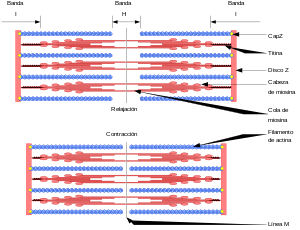Sarcomere
The sarcomere or sarcomere (Gr. σάρξ sarks 'flesh, body', μέρος meros 'part') is the anatomical and functional unit of striated muscle. It is limited by two Z lines with an A zone (anisotropic) and two semi-zones I (isotropic).
Its composition includes two proteins: actin and myosin. Muscle contraction consists of the sliding of thin actin myofilaments over myosin myofilaments (thick myofilaments), all of which is regulated by nerve intervention and the participation of calcium.
In band I of the sarcomere we can distinguish the actin filaments (thin filament) that arise from the Z discs, where there is alpha actinin, which is the protein that binds actin and titin. The latter is an elastic protein (the largest in the body), and has two functions:
- Keeps myosine in position.
- Because it has an elastic part, it acts as a spring recovering the length of the miofibrilla after muscle contraction.
In the A band of the sarcomere are the myosin filaments, which are responsible for muscle contraction.
Types of gangs and zones
- CA Band: Band composed of the thick wheels of 140 Å of myosine and fine actin. Inside we can also find:
- Area H: Area where there are only thick filaments - of myosin- visible, that is, corresponds to the sector of the band A where there are no fine filaments - of actin.
- Line M: Area where myosine is attached to the adjacent myosine, in which cardiovascular internal muscles are contracted.
- Band I: Band composed of the fine filaments of 80 Å of actin.
- Discos Z: Sector where adjacent actins are joined and continuity with the subsequent sarcomer is maintained. In them is found the CapZ protein.
During muscle contraction, Zone H disappears and Band I is compressed.
Contenido relacionado
Baboon
Whorl
Ichnanthus

